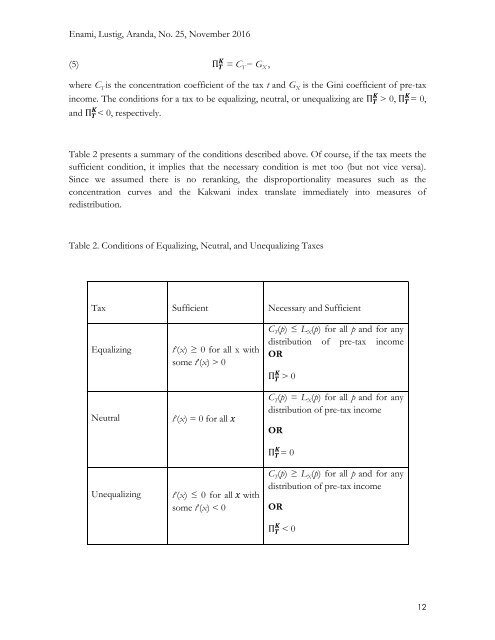IMPACT OF TAXES AND TRANSFERS
n?u=RePEc:tul:ceqwps:25&r=lam
n?u=RePEc:tul:ceqwps:25&r=lam
Create successful ePaper yourself
Turn your PDF publications into a flip-book with our unique Google optimized e-Paper software.
Enami, Lustig, Aranda, No. 25, November 2016<br />
(5) П T<br />
K<br />
= C T − G X ,<br />
where C T is the concentration coefficient of the tax t and G X is the Gini coefficient of pre-tax<br />
income. The conditions for a tax to be equalizing, neutral, or unequalizing are П T K > 0, П T K = 0,<br />
and П T K < 0, respectively.<br />
Table 2 presents a summary of the conditions described above. Of course, if the tax meets the<br />
sufficient condition, it implies that the necessary condition is met too (but not vice versa).<br />
Since we assumed there is no reranking, the disproportionality measures such as the<br />
concentration curves and the Kakwani index translate immediately into measures of<br />
redistribution.<br />
Table 2. Conditions of Equalizing, Neutral, and Unequalizing Taxes<br />
Tax Sufficient Necessary and Sufficient<br />
Equalizing<br />
Neutral<br />
Unequalizing<br />
t’(x) ≥ 0 for all x with<br />
some t’(x) > 0<br />
t’(x) = 0 for all x<br />
t’(x) ≤ 0 for all x with<br />
some t’(x) < 0<br />
C T (p) ≤ L X (p) for all p and for any<br />
distribution of pre-tax income<br />
OR<br />
П T K > 0<br />
C T (p) = L X (p) for all p and for any<br />
distribution of pre-tax income<br />
OR<br />
П T K = 0<br />
C T (p) ≥ L X (p) for all p and for any<br />
distribution of pre-tax income<br />
OR<br />
П T K < 0<br />
12



